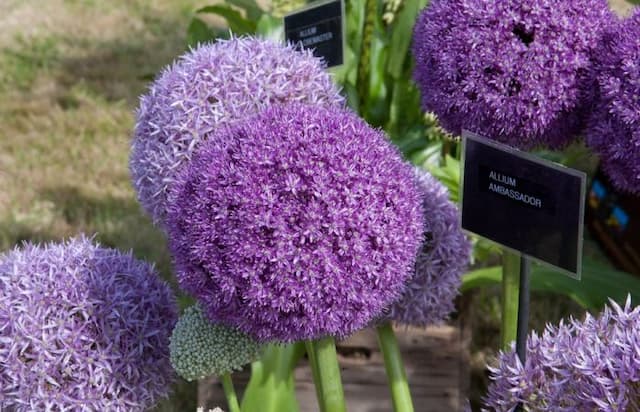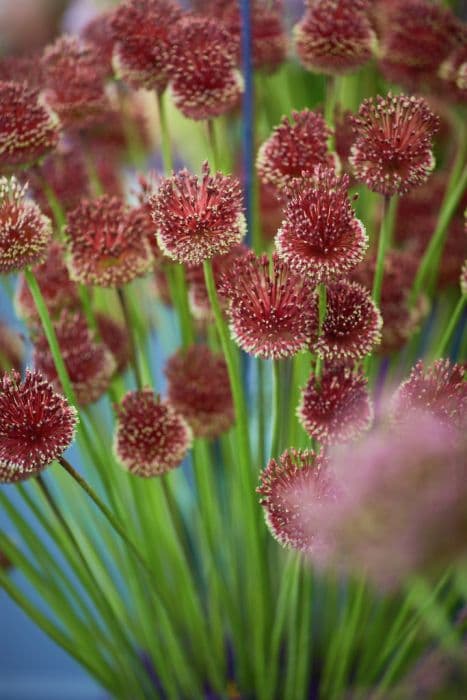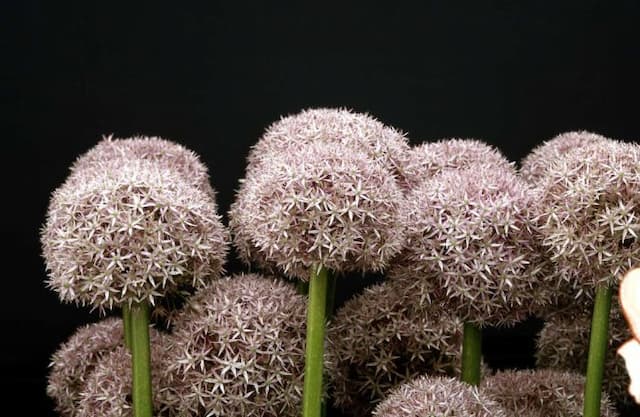Ornamental Onion Allium 'Universe'

ABOUT
Allium 'Universe' is a striking ornamental onion known for its large, spherical flower heads that create a visually stunning display. The flowers are a deep, rich purple that appear to almost be otherworldly, hence the name 'Universe'. These globes are comprised of numerous small, star-shaped flowers tightly packed together, forming an impressive bloom that resembles an exploding star or a fireworks display. The petals have a metallic sheen, giving the flower an iridescent quality. The foliage of Allium 'Universe' is typically a bright green and may have a glossy or matt texture. The leaves are long, slender, and strap-shaped, which provides a nice contrast with the bold, rounded shape of the blooms. After flowering, the seed heads maintain an attractive presence in the garden, with their skeletal forms offering both visual interest and potential for use in dried flower arrangements. Overall, Allium 'Universe' is a showy and dramatic plant that is often used to make a bold statement in gardens and landscape design.
About this plant
 Names
NamesFamily
Amaryllidaceae
Synonyms
Ornamental Onion, Flowering Onion
Common names
Allium 'Universe'.
 Toxicity
ToxicityTo humans
The Allium 'Universe' is an ornamental onion. Allium species can be toxic to humans if consumed in large quantities. Symptoms of Allium toxicity in humans may include gastrointestinal irritation, nausea, vomiting, and diarrhea. Though toxicity is generally low for human ingestion of small quantities, care should be taken to avoid excessive consumption, especially in individuals with a known sensitivity to alliums or those unable to properly metabolize the compounds found in them.
To pets
The Allium 'Universe', as an ornamental onion, is toxic to pets, especially cats and dogs. Ingestion of any part of the plant can lead to symptoms such as drooling, nausea, oral irritation, vomiting, diarrhea, lethargy, abdominal pain, elevated heart rate, and weakness. In severe cases, ingestion can lead to oxidative damage to red blood cells, which may result in hemolytic anemia. Immediate veterinary intervention is recommended if a pet is suspected of ingesting Allium 'Universe'.
 Characteristics
CharacteristicsLife cycle
Perennials
Foliage type
Deciduous
Color of leaves
Green
Flower color
Purple
Height
2-3 feet (0.6-0.9 meters)
Spread
1-2 feet (0.3-0.6 meters)
Plant type
Bulb
Hardiness zones
4-9
Native area
Asia
Benefits
 General Benefits
General Benefits- Ornamental Appeal: Allium 'Universe' has large, attractive blooms that add aesthetic value to gardens and landscapes.
- Pollinator Attraction: The flowers attract bees, butterflies, and other pollinators, supporting biodiversity.
- Low Maintenance: This plant is known for being easy to care for, requiring minimal watering and upkeep.
- Drought Tolerance: Allium 'Universe' can survive in dry conditions making it suitable for xeriscaping.
- Long Blooming Period: The plant has a lengthy flowering season, providing color and interest for an extended time.
- Deer and Rodent Resistant: The plant is not typically eaten by deer or rodents due to its onion-like taste and smell.
- Companion Planting: Its strong scent can help deter pests from neighboring plants when used in companion planting.
 Medical Properties
Medical PropertiesThis plant is not used for medical purposes.
 Air-purifying Qualities
Air-purifying QualitiesThis plant is not specifically known for air purifying qualities.
 Other Uses
Other Uses- Dye Source: The plant can be used to create natural dyes. Its leaves, when boiled, can impart a range of colors to fabrics, depending on mordants used.
- Educational Tool: Allium 'Universe' can be used in schools to teach students about plant biology, genetics, and hybridization processes, as it's a result of intentional breeding.
- Photography Subject: The striking spherical blossoms of the Allium 'Universe' make it a popular subject for photographers and can be used to enhance the aesthetic appeal of plant photography portfolios.
- Culinary Garnish: While not commonly used for consumption, the blooms could be used as an edible garnish to add a dramatic flair to dishes in haute cuisine.
- Artistic Inspiration: The unique form and structure of the Allium 'Universe' can inspire artists and be used as a reference for paintings, sculptures, and other forms of art.
- Garden Borders: These plants can be used to create striking garden borders, providing structure and height variation in landscape design.
- Feng Shui: The spherical shape of its flowers is said to bring a sense of harmony and completeness, making it ideal for Feng Shui applications in home gardens.
- Companion Planting: Allium 'Universe' can be planted alongside other garden plants to create a diverse ecosystem, as their strong scent can deter certain pests.
- Floral Arrangements: The long stems and spherical flowers make them perfect for inclusion in both fresh and dried floral arrangements.
- Event Decor: Can be used in decoration for special events such as weddings or parties, especially when a touch of natural, yet structured, elegance is desired.
Interesting Facts
 Feng Shui
Feng ShuiThe Allium is not used in Feng Shui practice.
 Zodiac Sign Compitability
Zodiac Sign CompitabilityThe Allium is not used in astrology practice.
 Plant Symbolism
Plant Symbolism- Unity and Humility: The spherical shape of the allium 'Universe' bloom, composed of many smaller flowers, symbolizes unity and togetherness, indicating that many parts can come together to create something beautiful and complete. It also implies humility in being just one part of a grand design.
- Patience and Perseverance: Alliums, like the 'Universe' variety, have a late spring or early summer bloom time, which can symbolize the idea of patience and the reward of beautiful blooms for those who wait.
- Strength and Stability: With their strong and sturdy stems, allium 'Universe' plants can represent strength and the ability to remain grounded, even in challenging conditions.
- Eternal Beauty: The name 'Universe' itself implies vastness and timelessness, suggesting a beauty that transcends the here and now, much like the stars in the night sky.
 Water
WaterOrnamental alliums, like Allium 'Universe', should be watered once a week with approximately 1 inch of water. It's important to water deeply to reach the roots, which encourages them to grow deeper into the soil. During hot and dry periods, you may need to water more frequently. In well-drained soil, ensure that the plant receives about a gallon of water each week. Reduce watering once the foliage begins to die back after flowering as the plant enters dormancy.
 Light
LightThe ornamental onion, or Allium 'Universe', thrives in full sun and should receive at least 6 hours of direct sunlight each day. The ideal spot for this plant is in an area that is exposed to the morning sun, which is less intense, and shielded from the harsh afternoon light. Partial shade is acceptable, but flowering may not be as prolific without sufficient sunlight.
 Temperature
TemperatureOrnamental onions, including Allium 'Universe', prefer moderate temperatures and can generally withstand a temperature range from 60°F to 75°F. They can survive in temperatures as low as 20°F and as high as 90°F. To ensure optimal growth and flowering, maintaining an environment close to the ideal temperature range is recommended.
 Pruning
PruningPruning ornamental onions like the Allium 'Universe' is generally done to remove spent flower heads and to maintain plant appearance. Deadhead the plant after flowering by cutting back the flowering stems to the base. This helps to prevent self-seeding and encourages a tidier looking plant. Pruning is typically performed annually, after the flowers have faded but before the seeds have fully developed.
 Cleaning
CleaningAs needed
 Soil
SoilThe best soil mix for ornamental alliums, commonly known as flowering onions, should be well-draining with a mix of loam, sand, and compost to provide nutrients. A pH of 6.0 to 7.0 is ideal for these plants.
 Repotting
RepottingOrnamental alliums typically don't require frequent repotting and can be repotted every 3-4 years or as needed if they become crowded in their current container.
 Humidity & Misting
Humidity & MistingOrnamental alliums are adaptable to a wide range of humidity conditions, as long as they are planted in well-draining soil and not waterlogged.
 Suitable locations
Suitable locationsIndoor
Provide well-draining soil, bright indirect light, and periodic watering.
Outdoor
Plant in well-draining soil, full sun, and water as needed.
Hardiness zone
4-9 USDA
 Life cycle
Life cycleThe Allium 'Universe', commonly known as ornamental onion, begins its life cycle when a gardener plants a bulb underground in late summer or early autumn. The bulb remains dormant during the cooler months, with root development occurring before top growth. In spring, green shoots emerge from the soil, developing into tall stems with strap-shaped leaves. By late spring or early summer, spherical clusters of star-shaped purple flowers bloom, attracting pollinators like bees and butterflies. After flowering, the plant sets seeds, which can be dispersed by wind or wildlife, although ornamental onions are often propagated by dividing and replanting bulbs. As the growing season ends, the foliage dies back, and the bulb enters a period of dormancy until the next cycle begins.
 Propogation
PropogationPropogation time
Spring to early summer
Allium 'Universe', commonly known as ornamental onion, reproduces primarily through division, which is the most popular method of propagation for this plant. The optimal time for dividing and replanting is in the fall, after the foliage has died back, or in early spring before new growth begins. For dividing, you would dig up the clump of bulbs when the plant is dormant, carefully separate them, and replant immediately to minimize stress and drying out. Each bulb should be planted at a depth three times its height, typically about 6-8 inches (15-20 centimeters) apart to allow for ample growing space. Water the new plantings thoroughly to encourage root development and help them establish quickly in their new locations.









